Why Your Fish Tank Turned Green Overnight (And How To Fix Green Aquarium Water Fast)
When you purchase through links on our site, we may earn a commission. Here’s how it works.
You walk over to your aquarium and stop in your tracks. The water, once crystal clear, now looks like split-pea soup. What happened? Is it dangerous? And more importantly, how do you fix it fast?
Green aquarium water isn’t just an eyesore: it’s a symptom of an imbalance in your tank. Whether it’s a light issue, a nutrient spike, or something more complex, identifying the cause is key to restoring clarity.
Table of Contents
The good news? You can often fix it in just a few days with the right combination of tools and techniques. This guide will walk you through the top causes of green water, the fastest ways to clear it up, and the best long-term strategies to maintain a balanced and beautiful tank.
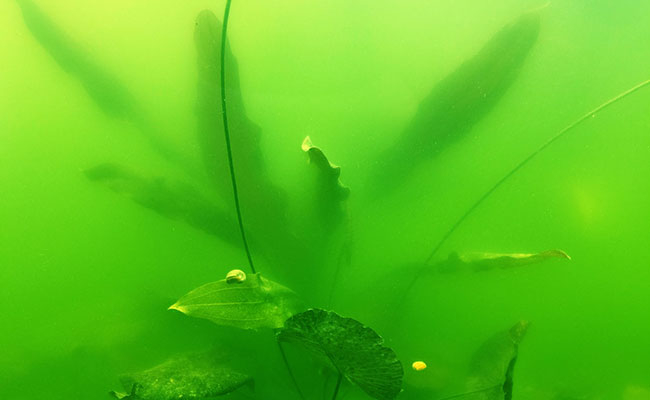
From UV sterilizers to blackout methods and algae-eating water fleas (yes, really), we’ll cover what works and what to skip, so you can get back to enjoying a clear, healthy aquarium.
| UV Sterilizer | Water Polishing Pad | Algae Treatment |
|---|---|---|
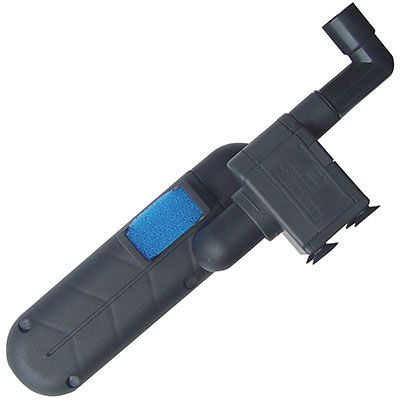 |  | 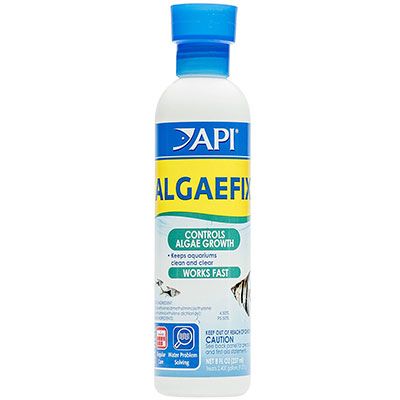 |
| COOSPIDER Aquarium Filter | Aquatic Experts Aquarium Polishing Filter Pad | API ALGAEFIX Algae Control |
| View on Amazon | View on Amazon | View on Amazon |
What Is Green Aquarium Water?
If your crystal-clear tank has turned into a green haze, you’re likely dealing with one culprit: a free-floating algae bloom called phytoplankton.
These microscopic organisms are invisible on their own, but when they multiply by the millions, they tint your water a hazy green. As their population grows, your tank can quickly shift from slightly cloudy to completely opaque, making it difficult to see your fish or plants.
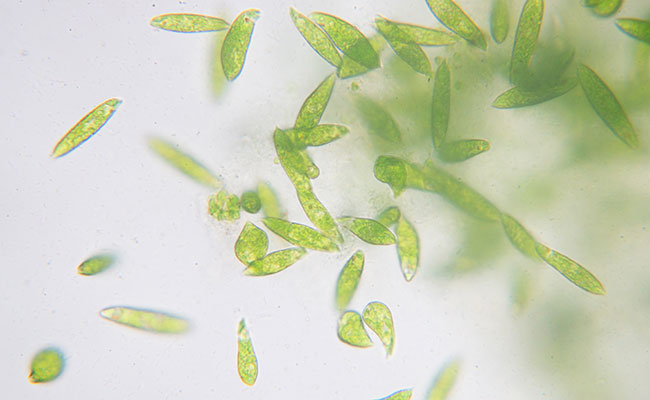
Phytoplankton vs. Other Algae Types
Unlike string algae or green dust algae, which cling to surfaces, phytoplankton stays suspended in the water column. This is what gives the entire tank a “pea soup” appearance.
Depending on your lighting, water parameters, and tank contents, green water may appear:
- Pale, hazy green or yellow-green in early stages
- Cloudy or even bright green during a full bloom
It is important to identify and address green water early, as it can rapidly take over your tank. You can get an idea of how this happens from the pictures below. Let’s walk through what that progression looks like.
Stage 1: Slight Haze
Initially, the water may take on a subtle green or yellow hue. Many aquarists mistake this for dirty glass or poor lighting, but it’s actually the first sign of a growing phytoplankton bloom.
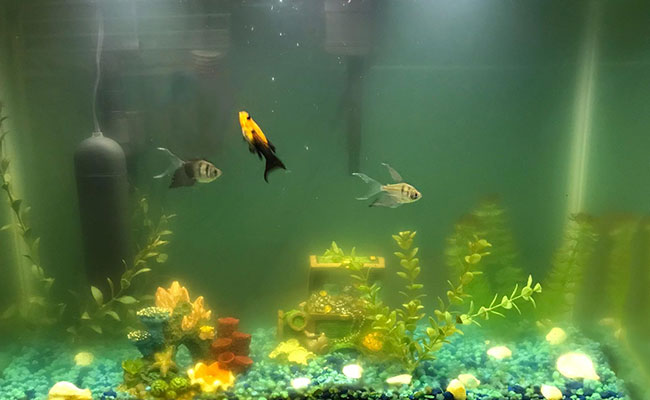
Stage 2: Cloudy Green Tint
As phytoplankton grow in number, they will turn the water into a cloudy, green mess.
At this point, visibility starts to drop. Fish and decor become harder to see, and the tank may appear dull or dim, even with the lights on. This is a clear indicator that intervention is needed.
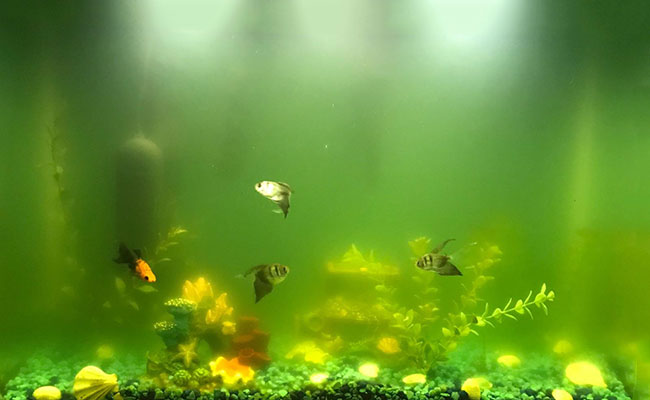
Stage 3: Full Bloom Takeover
If you don’t take action, the algae bloom can become so severe that it blocks out everything in your aquarium…
If left untreated, the bloom can reach a point where you can barely see an inch into the tank. This level of infestation can also disrupt plant growth by blocking light and reducing oxygen levels, particularly at night.
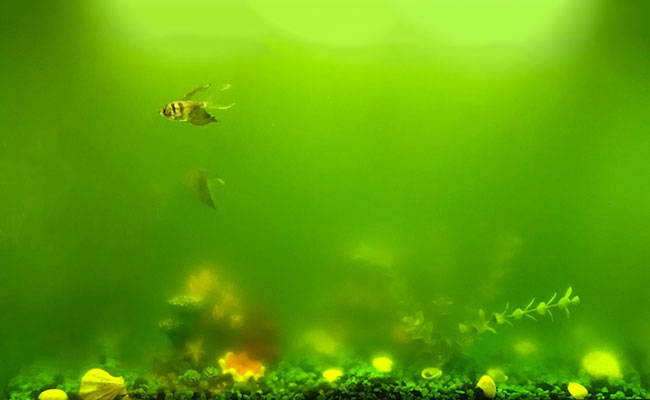
Stage 4: Color Variation
Different tanks will show green water in slightly different hues, depending on the intensity of light and the nutrients available in the water. But no matter the shade, the cause is the same: an unchecked bloom of suspended algae.
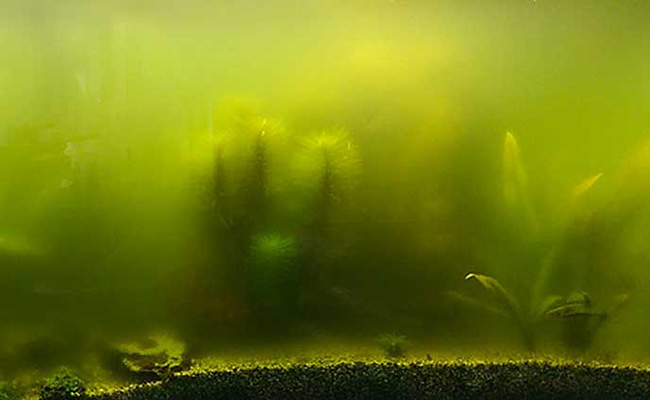
Why Early Detection Matters
As you’ve seen, green aquarium water rarely stays mild for long. Phytoplankton can double in population in a matter of hours under the right conditions. That’s why it’s essential to identify the issue early and take prompt action.
Is Green Water Harmful to Fish or Plants? When It’s a Nuisance vs. When It’s a Real Threat
Green aquarium water is often more unsightly than immediately harmful. In most cases, maintaining stable water parameters will not harm your fish or plants. Fish typically continue to behave normally, and most plants can tolerate mild reductions in light for a short time.
At this early stage, green water is primarily a visual issue that affects your enjoyment of the tank, rather than its overall health.
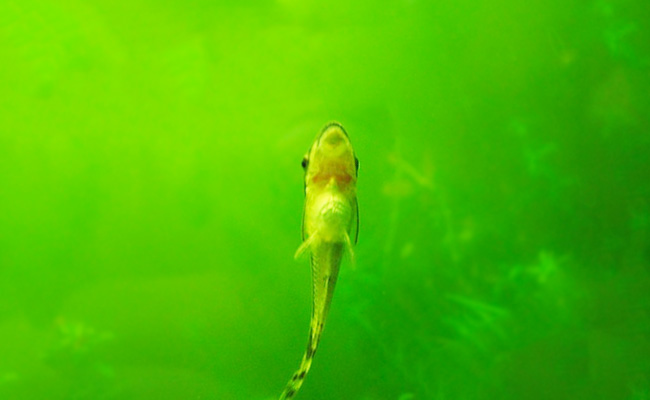
However, if the bloom becomes dense or goes untreated, it can create real issues. At night, phytoplankton consume oxygen, which can reduce available levels for your fish, especially in overstocked or poorly aerated tanks.
A thick algae bloom can also block light from reaching your plants, causing them to weaken over time. In severe cases, if the algae die off suddenly (such as after a chemical treatment), the resulting organic waste can spike ammonia and crash your water quality.
While green water isn’t directly toxic, it can quickly lead to secondary problems that stress your aquarium’s ecosystem. That’s why it’s best to treat it early, before it impacts oxygen levels, plant growth, or fish health.
Fun Fact
While most freshwater aquarium keepers view green water as a problem, some aquarists intentionally create it.
- In reef tanks and marine setups, phytoplankton—the same microscopic algae that cause freshwater to turn green—are intentionally cultured and added to the system. Why? It serves as a nutritious food source for filter feeders, such as corals, clams, and copepods.
- Phytoplankton is rich in omega-3 fatty acids and plays a crucial role in marine food chains. In fact, many reef keepers dose live phytoplankton regularly to boost coral color, polyp extension, and overall tank biodiversity.
So while it’s an eyesore in a freshwater display tank, in the saltwater world, green water can be a sign of expert care.
Is It Really Green Water, or Something Else?
Green aquarium water is often mistaken for green dust algae. Although they may appear similar, they behave quite differently.
Look at the image below. On the left, you’re seeing green aquarium water. On the right, a tank coated in green dust algae. At first glance, they look almost identical.
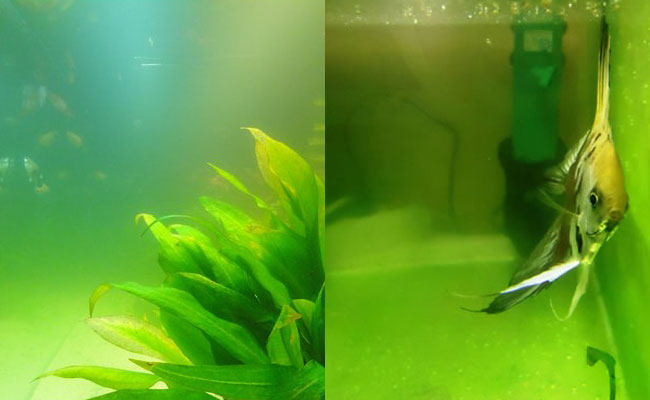
But here’s the difference: green dust algae doesn’t float freely in the water. It clings to surfaces, glass, plants, and substrate, and only becomes suspended if it’s disturbed. That means the water itself isn’t actually green. It just appears that way because light is reflecting off the algae coating the inside of your tank.
Below, you see what happens when you clean green dust algae off a single panel of glass.
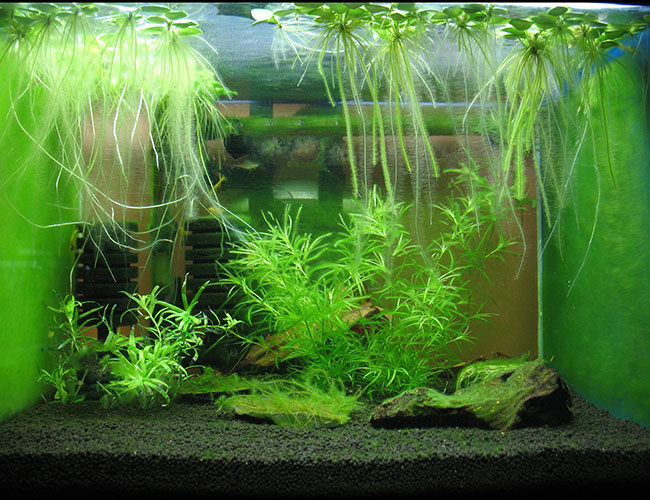
The aquarium water looks clear again because the water itself doesn’t contain any algae, just the surfaces. The algae in green aquarium water prefer to float through your water, without settling on any surfaces.
Key Differences Between Green Water and Green Dust Algae
This chart breaks down the differences between green aquarium water and green dust algae:
| Green Aquarium Water (Phytoplankton) | Green Dust Algae |
|---|---|
| Algae floats in the water column | Algae sticks to surfaces |
| Water appears green even in a glass sample | Water looks green due to algae-coated surfaces |
| Does not settle on glass or decor | Covers glass, plants, substrate |
| Cannot be removed by scrubbing surfaces | Can be wiped or scraped off easily |
How to test it:
Scoop out a small amount of water in a clear glass or container.
- If the water itself is green, you are dealing with phytoplankton.
- If the water looks clear, but your tank still appears green, it is likely green dust algae that is reflecting light off surfaces.
Note: Be cautious when identifying algae in your aquarium. Algae typically appears when there is an imbalance of nutrients, and it is possible to have more than one type in your tank at a time. If you suspect green dust algae instead, refer to our dedicated guide on how to remove it effectively. We also cover top strategies for algae control.
Quick Recap
- Green aquarium water is caused by free-floating phytoplankton
- It is different from surface-bound algae, like green dust
- Proper identification is essential before choosing a treatment
4 Top Causes of Green Aquarium Water: Why Algae Blooms Take Over Your Tank
If your tank has turned cloudy or green seemingly overnight, it’s not just bad luck. Green water is almost always the result of an imbalance, such as excessive light, high nutrient levels, or inadequate maintenance. Fortunately, once you understand the root causes, you can correct the problem and prevent it from happening again.
Below are the four most common reasons why green water develops in freshwater aquariums. Identifying which one applies to your setup is the first step toward restoring balance and clarity.
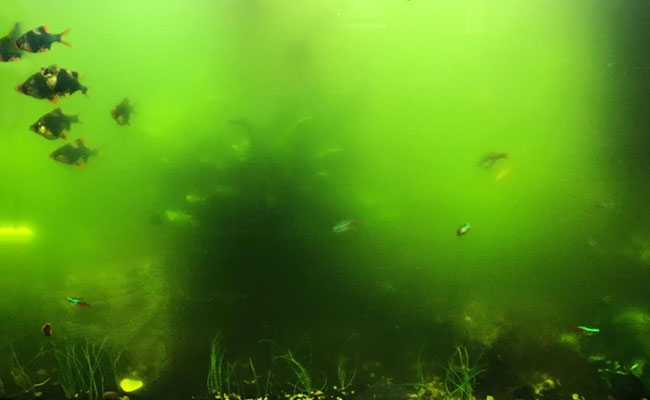
The general consensus among the aquarium community is that there are three main causes of green water algae. Staying on top of these causes will go a long way toward preventing green aquarium water.
1. Too Much Light Exposure
Green water is caused by free-floating algae (phytoplankton), and like all plants, algae rely on light to grow. When your tank receives more light than it needs, whether from artificial sources or sunlight, it creates an ideal environment for algae to multiply rapidly.
This is one of the most common and often overlooked causes of green aquarium water, particularly among new hobbyists. Many aquarists unintentionally fuel algae blooms by keeping the lights on too long or placing the tank in a brightly lit area.
Here are some of the most frequent lighting mistakes that contribute to green water:
- Leaving aquarium lights on 24 hours a day (most tanks need only 8 to 10 hours)
- Using high-intensity grow lights in tanks without live plants
- Placing the tank in direct sunlight (even a few hours of afternoon sun can fuel an algae explosion)
Solution: Install a simple aquarium light timer to automate your schedule and prevent overexposure to light. If your tank is near a window, consider moving it or keeping curtains or blinds closed during peak sunlight hours.
Even small reductions in light duration and intensity can dramatically slow algae growth.
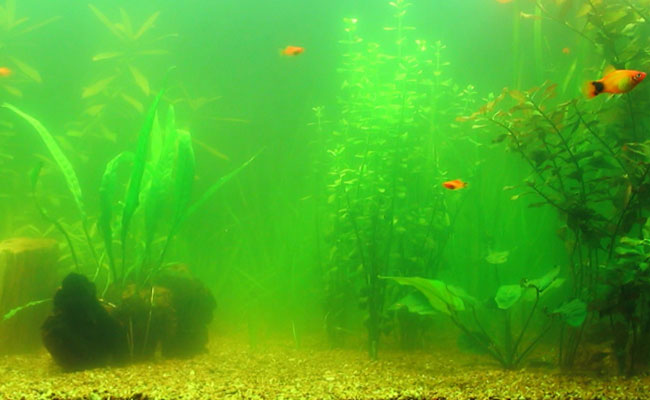
But it’s not just your aquarium lighting that could be responsible for your green water problem. Sunlight could also be the cause.
It can be easy to miss while you are at work, but during the daytime, the sun can shine through your windows, bathing your aquarium in light. It’s basically inviting green water into your aquarium!
This is why the ideal location to set up your fish tank is away from direct sunlight. If it’s too late for that, you have another option… Keep your curtains drawn!
2. Nutrient Imbalance (Nitrates and Phosphates)
Light alone doesn’t cause green water. Algae also need nutrients to grow, and an imbalance in your water chemistry gives them exactly what they need to thrive. This is especially true in tanks where fertilizers are used for plants or where organic waste builds up over time.
If your water tests show elevated phosphate or nitrate levels, you may have found the real reason behind your algae bloom.
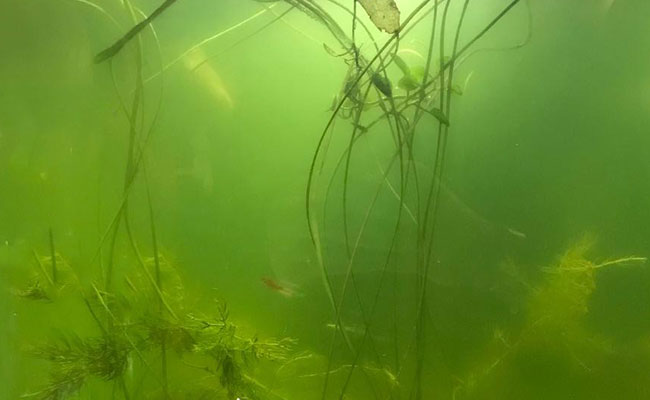
Common nutrient sources include:
- Overfeeding your fish
- Uneaten food and decaying plant matter
- Excessive fertilizer dosing in planted tanks
- Poor or infrequent water changes
When levels of nitrates, phosphates, or CO₂ are too high or out of balance, it creates ideal conditions for phytoplankton to explode in number.
How to fix it: Start by testing your water using a reliable aquarium test kit. Focus on nitrate, phosphate, and CO₂ levels. If anything is unusually high, take action:
- Reduce feeding and remove uneaten food
- Vacuum the substrate to eliminate waste buildup
- Cut back on fertilizer dosing if you’re running a planted tank
- Perform more frequent water changes
Balanced nutrients are key not only to preventing algae, but also to maintaining the health of your fish and plants.
3. Infrequent Tank Maintenance and Overfeeding
Even if your lighting and nutrient dosing are dialed in, neglecting basic maintenance can easily trigger a green water outbreak. Leftover food, fish waste, and dirty filters gradually release nutrients into the water, creating the perfect storm for green water to appear.
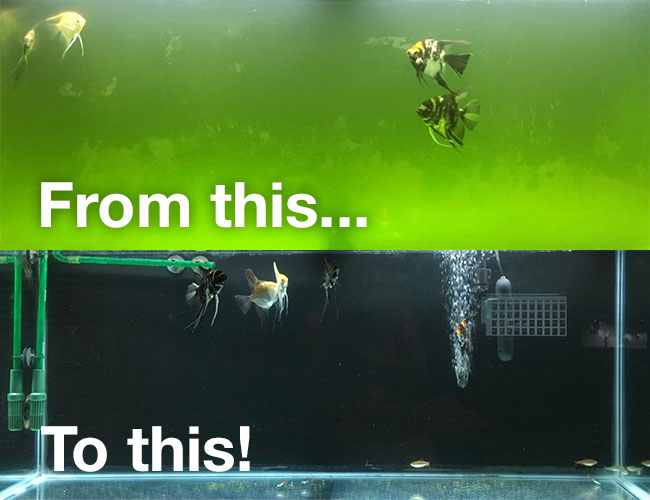
Neglecting regular upkeep is one of the most common mistakes new aquarists make, but it is also one of the easiest to fix.
Warning signs of poor maintenance include:
- Cloudy or foul-smelling water
- Excess food or debris is collecting at the bottom
- Dirty filter media or clogged equipment
- Algae growth on glass and decor
The solution? Create a weekly maintenance routine that includes:
- Changing 20 to 30 percent of the tank’s water
- Vacuuming the gravel or sand to remove detritus
- Rinsing or replacing filter media as needed
- Avoiding overfeeding (fish should consume food within 1 to 2 minutes)
- Keeping an eye on stocking levels to prevent waste overload
- Check your water quality (use an aquarium test kit!)
Consistency is everything. Routine care helps maintain stable water quality and prevents the development of conditions that allow algae to thrive.
4. Lack of Live Plants or Algae Competition
Aquariums without live plants are missing a key part of the natural ecosystem, nutrient competition. In the absence of plants, algae face no resistance as they absorb available light and nutrients. The result? An unchecked bloom that clouds your water.
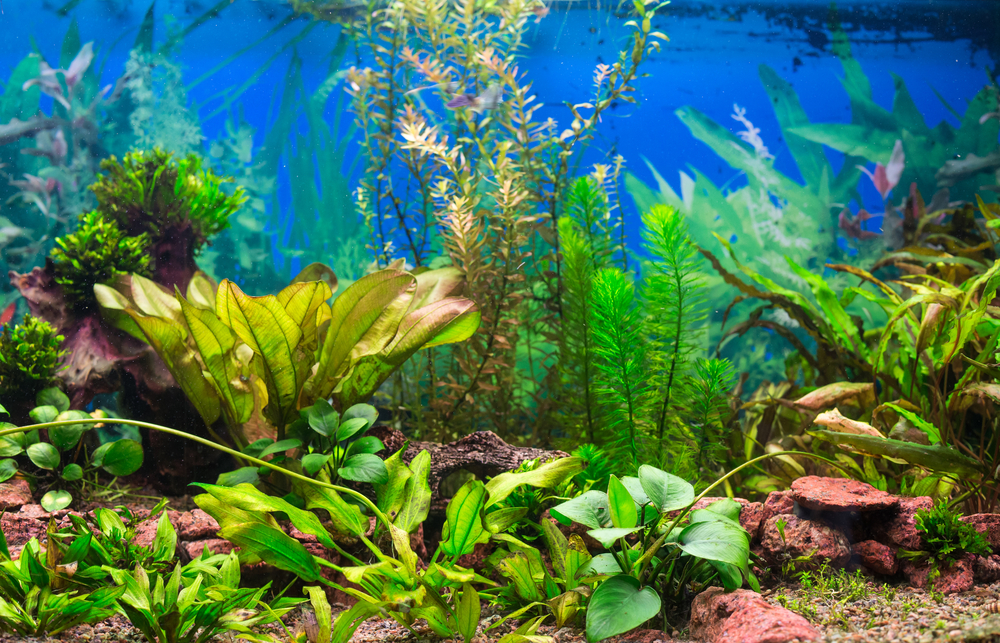
If your tank is fish-only or minimally planted, adding even a few hardy plants can shift the balance in your favor. This is especially true in tanks with high lighting or fish that produce a lot of waste. Without plants to use up those nutrients, algae will absorb them and bloom freely.
How to fix it: Introduce live plants into your setup to provide natural competition for light and nutrients. Great options include:
- Fast-growing stem plants like hornwort, water wisteria, or anacharis
- Floating plants like duckweed, frogbit, or Amazon frogbit
- Rooted plants like Vallisneria or crypts for deeper nutrient uptake
Plants not only reduce algae, but also improve oxygen levels, stabilize water chemistry, and create a more natural environment for your fish.
Watch Before You Start: How to Fix Green Aquarium Water
Before we dive into each method in detail, check out this video from FishLab for a quick overview of what causes green water and which solutions actually work. It covers the pros and cons of common fixes like UV sterilizers, blackout treatments, and more—so you can see what to expect before taking action.
Once you’ve seen how these approaches work in real tanks, scroll down for a step-by-step breakdown of each method.
5 Best Short-Term Fixes to Clear Green Aquarium Water Fast
Once green water has taken over your aquarium, it won’t go away by itself. Phytoplankton multiply rapidly in the right conditions and must be physically removed, killed, or starved to restore clarity.
Below are five short-term methods that hobbyists commonly use, each with its own strengths, limitations, and important details to consider before diving in.
1. UV Sterilizer – Fastest Way to Kill Free-Floating Algae
A UV sterilizer is widely regarded as the most effective and reliable method for clearing green water. As water passes through the unit, it’s exposed to UV-C light that destroys phytoplankton cells, stopping them from reproducing. Most tanks show visible improvement within 3 to 5 days, sometimes even faster.
This is actually my favorite tool for removing the awful green tint from your aquarium. Not only is a UV sterilizer safe for fish, invertebrates, and plants, but it requires no effort on your part – simply turn it on and forget about it.
Pricing
Best for: Moderate to severe algae blooms, especially in tanks with good flow and filtration.
- Pros:
- Fast, chemical-free results
- Low maintenance once installed
- Also controls bacteria and parasites
- Cons:
- Requires correct wattage and flow rate to be effective
- Doesn’t remove dead algae; water may remain cloudy without polishing
- Upfront cost is higher than that of other solutions
Important note: Effectiveness depends on proper setup. Undersized UV units or water moving too fast through the chamber won’t kill algae effectively. Always match the UV unit to your tank size and flow rate.
2. Water Polishing Pad – Trap and Remove Microscopic Algae
Polishing pads are ultra-fine filter inserts that can capture small suspended particles, including phytoplankton. They won’t stop algae growth, but can help improve water clarity over time, especially when paired with water changes.
Pricing
Best for: Mild blooms or follow-up polishing after a UV sterilizer or blackout treatment.
- Pros:
- Easy to add to most canister or HOB filters
- Inexpensive and reusable (if rinsed properly)
- Doesn’t affect livestock or plants
- Cons:
- Slower to show results than UV or chemicals
- Pads may clog quickly with heavy algae loads
- Doesn’t stop algae reproduction
Clarification: Some guides overstate the impact of polishing pads. They help clear dead or suspended algae, but won’t kill algae or stop regrowth without addressing the root cause.
3. Chemical Algae Treatments – Quick Results with Risks
Algaecides, also known as “green water treatments,” can kill phytoplankton quickly, often within 24 to 72 hours. However, they must be used with care. A sudden die-off can cause a spike in ammonia and drop oxygen levels, making it especially hazardous in heavily stocked tanks.
Using chemicals to treat green water isn’t my first choice—not because they don’t work, but because they can be unpredictable. Every tank is different, with its own mix of fish, plants, and equipment, so what works in one setup might harm another.
Algaecides are effective, but they carry risks. It’s easy to find stories of fish losses linked to these treatments, often due to overdosing. Beginners, especially, may rush the process, causing more harm than good.
Pricing
Best for: Emergencies or dense blooms when other options have failed.
- Pros:
- Fast-acting
- Easy to dose
- Readily available in stores
- Cons:
- Risk of harming fish, shrimp, or plants
- Can destabilize the tank if used incorrectly
- Does not solve the root cause
Important note: Algaecides should be a last resort. Always follow dosing instructions exactly, increase aeration during treatment, and monitor ammonia and oxygen levels closely. Never mix with other treatments unless specified as safe.
4. Daphnia (Water Fleas) – A Natural but Inconsistent Algae Eater
Daphnia are tiny, filter-feeding crustaceans that consume phytoplankton. In theory, they can help reduce green water naturally. But in practice, they are often eaten by fish before they make a difference, and their population takes time to establish.
Best for: Outdoor ponds or indoor breeding tanks without fish.
- Pros:
- Completely natural
- Adds biodiversity to the ecosystem
- Safe for sensitive tanks (if fish aren’t present)
- Cons:
- Often ineffective in community tanks
- Easily predated by fish
- Results take weeks, not days
Clarification: Some hobbyists claim Daphnia clear green water “quickly,” but that’s misleading. Even under ideal conditions, it can take one to two weeks, provided they survive long enough to reproduce. Not a practical solution in most home aquariums.
5. Blackout Method – Eliminate Algae with No Tech or Chemicals
The blackout method involves covering your tank for several days (typically 3 to 5) to block all light and starve the algae. This method is chemical-free, affordable, and effective for mild to moderate blooms—if done properly.
Best for: Early-stage blooms or tanks where equipment or chemicals are not an option.
- Pros:
- No cost or gear required
- Works well with nutrient control
- Doesn’t harm fish if oxygen remains adequate
- Cons:
- Can stress or damage light-dependent plants
- Water may still look cloudy afterward
- Algae may return if root causes aren’t fixed
Important note: Ensure good aeration during blackout, and monitor parameters after reintroducing light. Combine with water changes or filtration upgrades to remove dead algae post-treatment.
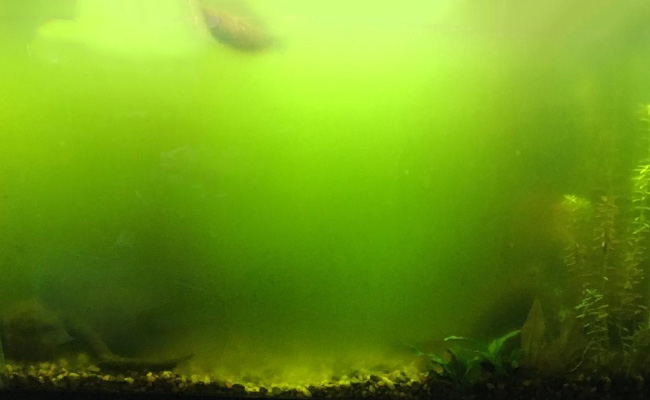
Bonus Tip: Use a Magnetic Algae Cleaner for Better Visibility
While magnetic glass cleaners won’t remove green aquarium water itself, since the algae is suspended in the water column, they’re extremely helpful for cleaning up green dust or film algae that builds up on the glass during a bloom.
Removing this surface layer can dramatically improve visibility, help you monitor your fish during treatment, and make your tank look cleaner while you work on fixing the root cause of green water.
Pro tip: Clean the glass before using blackout methods or UV sterilizers so you can better track your progress.
Choose the Right Tool for Your Tank
Each method has its place, but no single fix works for everyone. Here’s a quick guide:
| Method | Best For | Speed | Risk |
|---|---|---|---|
| UV Sterilizer | Long-term control | Fast | Low |
| Polishing Pad | Mild blooms or aftercare | Moderate | None |
| Algaecide | Emergencies only | Fast | High if misused |
| Daphnia | Ponds, no-fish tanks | Slow | High failure rate |
| Blackout | Mild blooms, budget tanks | Moderate | Low if done right |
For optimal results, pair a short-term solution (such as UV or blackout) with long-term prevention strategies, including nutrient control, proper lighting, and plant balance.
5 Long-Term Solutions to Prevent Green Aquarium Water
Preventing green water comes down to creating a stable environment that makes it harder for algae to grow. These five strategies work together to reduce excess light and nutrients while supporting overall tank health.
- Use Live Plants – Fast-growing and floating plants, such as hornwort, duckweed, and water sprite, absorb the same nutrients that algae feed on. They also shade the tank, helping to prevent light from fueling blooms.
- Control Light Exposure – Limit artificial lighting to 8–10 hours per day using a timer. Avoid direct sunlight, which can trigger blooms even in well-maintained tanks.
- Stay on Top of Maintenance – Perform weekly water changes (20–30%) and clean your filter media regularly. Vacuum the substrate to remove decaying waste that feeds algae.
- Balance Nutrients – Use a test kit to monitor nitrate and phosphate levels. Keep them within ideal ranges (nitrate below 40 ppm, phosphate under 1 ppm), and adjust feeding or dosing accordingly.
- Feed Carefully – Only feed what your fish will eat in 1–2 minutes. Overfeeding leads to uneaten food, which breaks down and fuels algae growth.
When to Get Help: Persistent Green Water Issues
If you’ve tried multiple fixes and your water remains green after a week or more, it may be time to seek professional help. A local aquarium shop, aquatic veterinarian, or reputable online forum can help troubleshoot your unique setup. Persistent green water is often a sign of deeper imbalances that require expert insight.
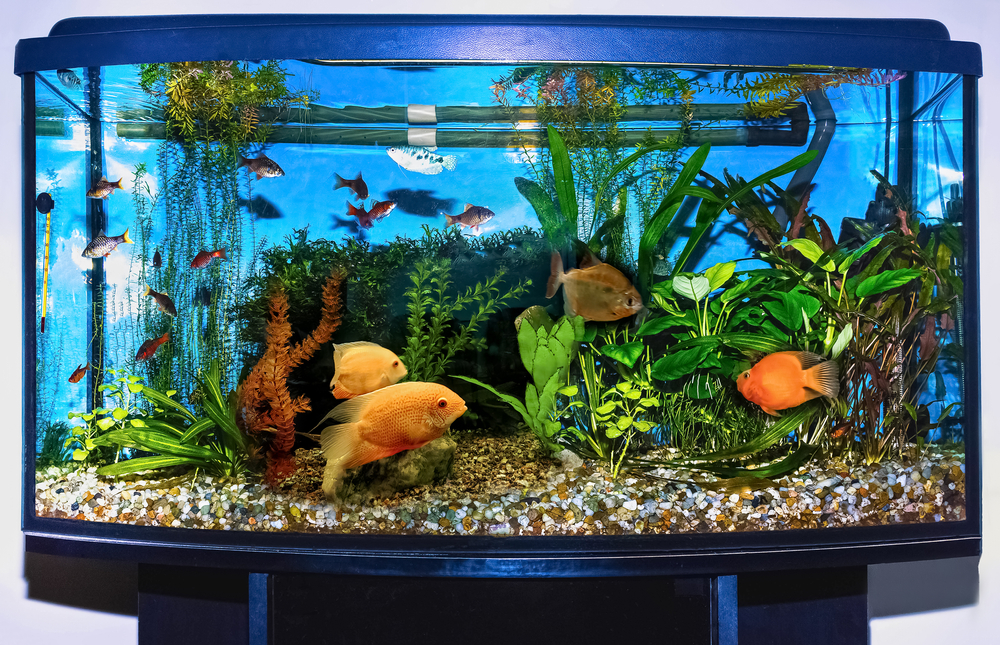
Quick Reference Checklist: Clear Water Action Plan
Use this simple 10-step checklist to stay on top of green water prevention and response:
- Limit light to 8–10 hours per day
- Avoid direct sunlight on the tank
- Test for nitrates and phosphates regularly
- Perform weekly water changes (20–30%)
- Use a UV sterilizer for long-term control
- Add fast-growing live plants for nutrient balance
- Avoid overfeeding and remove uneaten food
- Rinse or replace filter media regularly
- Use blackout or polishing pads as needed
- Seek expert advice if problems persist
What to Do Next: Keep Your Aquarium Clear, Safe, and Balanced
Now that you know how to clear green water, the next step is to prevent it from returning. Make sure your tank is properly cycled, avoid common fishkeeping mistakes, and feed a balanced diet to reduce excess nutrients.
For long-term success, consider exploring how to create a self-sustaining aquarium and commit to regular cleaning routines to keep your water parameters stable. And if you notice surface issues like film or cloudiness returning, check out our guide to oil and protein films, another common but solvable aquarium nuisance. With the right knowledge and maintenance habits, you can enjoy a crystal-clear, thriving aquarium that stays balanced year-round. Keep learning, stay curious, and your fish will thank you.
Share Your Green Water Story
Have you battled green aquarium water in your tank? Got a clever fix or a lesson learned the hard way? We’d love to hear about it. Respond with your tips, questions, or success stories below. Your experience might just help another aquarist find their way to crystal-clear water!

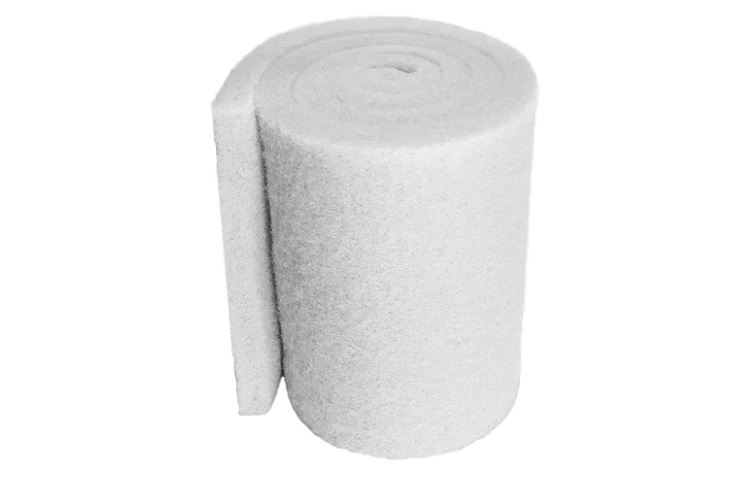

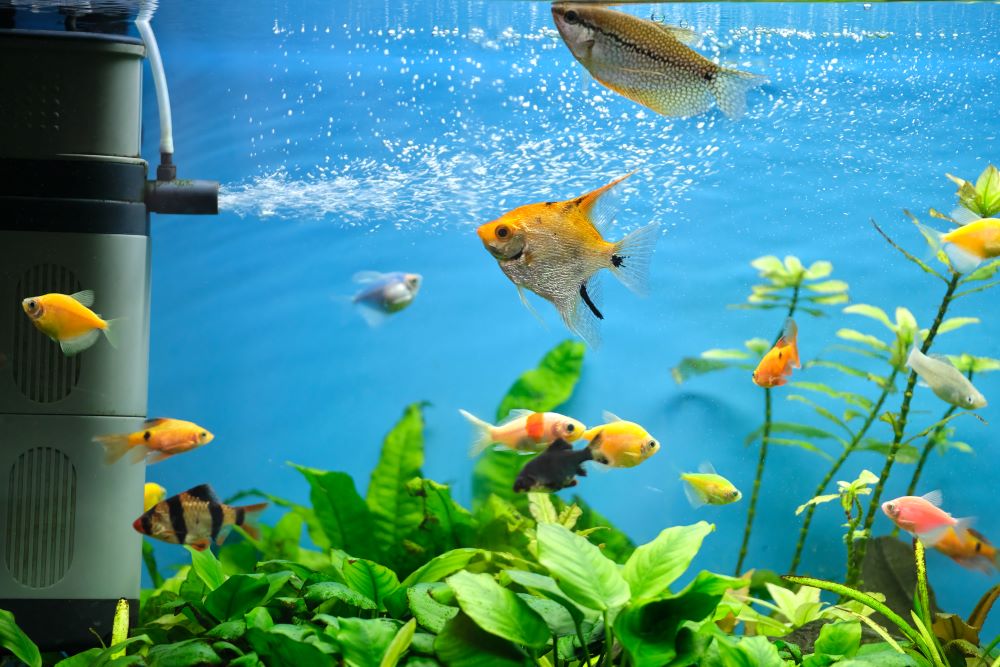
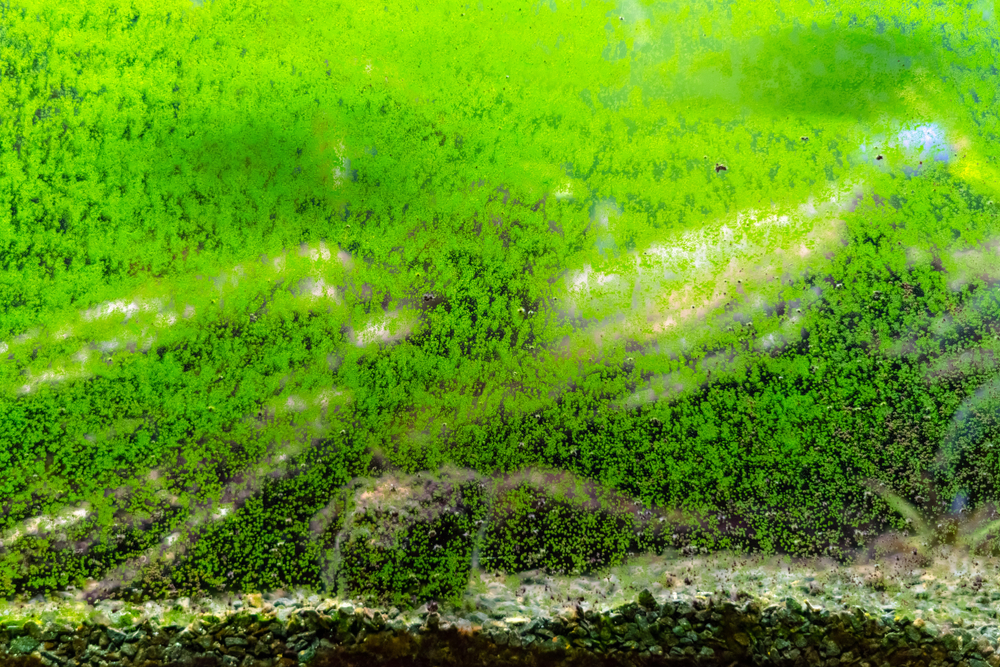
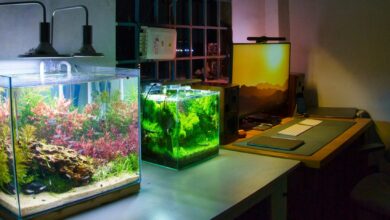
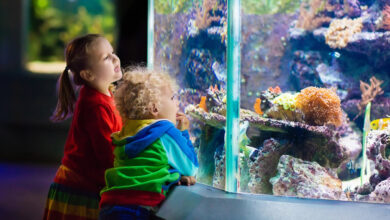
Tank info
1. 55 gal freshwater
2. Temp 78.3
3. Zero ammonia, nitrite; 140 nitrate
4. 12 hour fluorescent lite
5. Alot of fish really
6. HOB 200gph 2 powerheads for undergravel filter 100 gph each
7. 8-10 gal water change per week
How I got rid of green water
1. Changed 1 of two filter pads to keep some good bacteria in HOB
2. Used 10 gals of distilled water (.89 per gal) used water conditioner and salt prior putting water into tank
3. Water just cleaned upped nicely that day very quickly
Hi Brad,
Thanks for the update on your tank! Just to clarify, your nitrate levels were 140 ppm? That is ridiculously high. The excess nitrate was possibly being used as a food source for algae that turned your water green.
hi Brad-
I’ve been freshwater fish keeping for about 56 years & recently got a horrible GREEN ALGAE BLOOM I never use chemicals but I did manage to cure it after weeks of frustration , I blocked all light to my tank for 3 weeks it is now crystal clear…what caused it was, I’d accidentally replaced my fluorescent tube with a marine tube which was giving to much light.mick
Hi Michael,
Thanks for weighing in. That’s such an easy mistake to make. Hard to believe using a different tube was all it took. I’m glad it was an easy solution where you didn’t have to use chemicals!
Thanks Ian–yes….just goes to show your never to old to learn in Fishkeeping.Enjoy,Michael.
I have this happening now and I’m curious on what to look for in a uv sterilizer and what is a good brand. I have a 40 gallon.
Hi John,
If you are located in America, the AA Aquarium Green Killing Machine would be my go-to recommendation for hobby tanks. It’s pretty fool proof.
What size UV would I need for a 20 gal. tank? Should it run 24/7?
Hi Wanda,
Something like this is the right size for a 20 gallon. The next size down, a 3 watt would be too small. You can leave it to run 24/7 or if you are energy conscious, every time you see green algae appear. Either or, it won’t harm your tank.
I had a problem with greenish water for over a month and was going to try a polishing pad as I did not want to use chemicals. Instead, I used an old thick terry cloth wash cloth and cut it up in squares and placed it between the foam insert and charcoal insert in my aquaclear. Works like a charm.
Hi Brian,
That’s pretty clever – A DIY polishing pad. My only concern with repeating this would be the dyes and other chemicals that these can contain leaching into the aquarium, particularly in tanks containing sensitive fish. But that’s fantastic that you came up with your own solution!
Hi Ian,
I thought about that. I used a white terry wash cloth washed in tank water and made sure to line dry it and never used dryer sheets on it. My tank is now crystal clear and the wash cloth is green.
Hi again, Brian.
That’s the kind of clever thinking and attention to detail I can get behind! I love it. You have me intrigued now, and would love to experiment with how effective it is. I think this is may be a viable option for those who do not have affordable polishing pads available. My preference at the moment is to buy a bulk slab and cut to size, it’s very affordable if you plan on being in the hobby for a long time. However, terry cloth would likely be easier to wash and reuse – my experience with fine polishing pads, especially those around 50 micron, is that they have to be disposed of once they clog. Have you tried washing and re-using your design yet?
Hi Ian,
I’m going to leave it in for a few days to see if it continues to filter or if will be chocked up by algae. Even if I can’t reuse the piece of wash cloth currently in the filter, there’s so much wash cloth left that I can probably get another 8 pieces out of it. The trick was to make sure there is enough fabric in between the 2 filter that water doesn’t go around the wash cloth. Cost wise if you go to a dollar store and buy a wash cloth for a dollar or so it will probably be extremely cost effective.
Hi Ian,
I decided to change the first piece of wash cloth I placed in the filter pack. It was white when I started and a dark green when removed. I washed it out and placed it back in the filter pack. After a few days the tank had a very slight cloudy appearance. I think the problem with reusing the piece of original cloth was so it was saturated with algae that it became the problem. The second piece I placed at the bottom of the filter pack and again it remove any existing algae. I don’t think reusing the fabric would be a good solution but using a piece of wash cloth is a very effective and cost efficient solution to getting rid of algae, I tested the chemistry of the tank before and after and it slightly reduce the nitrate levels not that they were high.
Hi Brian,
Thanks for following up with this. It seems that it faces a similar problem as filter floss in that due to the fine pores, they are neatly impossible to wash and re-use. If someone can’t track down affordable filter floss, then this seems like a great idea. Once again, thanks so much for sharing!
I have 150 gallon African cichlid tank I have never had a green algae bloom before the only thing I changed was my filtration. I had two emperor four hundreds and a marine land 220 canister. I switched to the fluval Fx6. The switch happened two months ago I am now plagued with green water. No changes on location of tank no changes on lighting Any thoughts? I’ve been an avid Aquarist for more than 20 years So I’m no stranger to the hobby this situation just blows me away
Hi Mike,
Unfortunately, this is a tricky one to diagnose, I would not expect the Fluval to be the cause, especially if it was two months ago. It’s likely you are think back to the most profound change made in the tank, but it’s likely something else that has happened since. If you remove the green algae using a uv sterilizer or diatom filter,and it doesn’t come back, then it was a one off coincidence. If it keeps appearing, then it has a food source that needs to be cut back.
My filter stopped working and I didn’t notice because of my castle bubbler. When I noticed it had maybe been 2/3 weeks I didn’t have money for a new filter at the time. I have a big tank so another 2 weeks went by. I did a 50% water change and fixed the filter. Still green. I’m about to buy a uv filter because I can’t find an algae clumper and don’t want to use chemicals. What do you recomend?
Hi Jay,
Have you tested your water with an aquarium test kit first? This will determine if there is an obvious imbalance that needs to be fixed – for instance, your tank might need to be cycled again. You might not need to buy a UV sterilizer if you can fix it manually – UV sterilizers are not exactly cheap.
If everything looks normal and you still want to go the UV Sterilizer route, the AA Aquarium Green Killing Machine is the most reliable in terms of price and performance. They have replacement bulbs sold separately and last for years.
Hi there Ian. I am a small time aquarium operator compared to you guys but I hope you can help me. I have a 2.5 gallon Fluval brand tank for one betta fish, one snail and a live plant. I have a biological filter that keeps all the N levels where they should be. I got the snail to help with the algae dust (the kind that sticks on surfaces and he does a good job with it). But the tank is overrun with floating green algae. I do a 50% water change / gravel vacuum every 7-10 days. I have added a scrubbing pad as you recommended to the filter area. I have moved the tank away from the window. Still green water forms in 2 days after change. Any suggestions? Would the UV filter you recommend be appropriate to use in my tiny tank? Thank you! I appreciate any feedback.
Hi Laura,
Just so we are on the same page, your ammonia, nitrite and nitrate levels all look good? I only ask as a two day build up is shockingly fast – the algae would have to be feasting on a good food source for it to take over your tabk so quickly – even though it sounds like you are doing everything right.
In your case, it’s possible you may need to buy a UV sterilizer as a last resort. While a UV sterilizer will certainly work, but it will also take up a chunk of room in your tiny tank. It’s possible that the UV sterilizer may kill it all outright and you might need to just use it this once (or on occasion in the future) or it’s possible that you’ll need to use it on an ongoing basis unfortunately, this entirely depends on the rate that the algae builds up.
I have a 55 gallon freshwater tank I have done it all from water changes to buying a uv filter. My tank is still green what can I do.
Hi Tammy,
Is the UV filter you purchased the correct size for your tank? If it isn’t then it might not treat the free-floating algea quickly enough to kill it off.
It’s for a 75 gallon tank
Just another few questions…
Does the UV filter work? It can be hard to tell since the bulb itself is covered and may not actually be lighting up. You might have a faulty unit
Be particularly careful here, you shouldn’t look at UV bulbs. Refer to the instructions for more info.
Next, is the algae free floating? UV filters and water change will only get rid of free floating algae. Algae that clings to surfaces needs alternate methods of removal.
Finally, what are your tank parameters – the most common reason algae appears is there is a food source for it. Are lights on 24/7, is direct sunlight hitting it? What are you ammonia, nitrite and nitrate levels?
Just want to appreciate for your guidance. Good Job Sir.
Hi Shahid,
Thank you for the kind words, I hope you were able to fix your green water problem!
Hello Ian
I have 75 gallon tank and I just bought the green killer machine (24w up to 100gal) 5 days ago and the water is not getting worse and it’s getting clear only a bit.
Do you know after how many days the water on my tank would be clear? I have my lights on for 7 hours every day ( timer)
Thanks for support
Hi Fransisco,
If it’s exceptionally bad, I would perform daily or bi-daily 50% water changes alongside continuous UV treatment. This 1-2 punch should get rid of it, assuming all your water parameters are within your desired range (planted tanks often need extra balancing)
Hello Ian
Thanks for your quick response. I will follow your recommendations and keep you posted.
Thanks for the support
Francisco
Good luck Francisco,
I have my fingers crossed you are able to get rid of this green menace!
Just a big thank you !
My husband has a 400l tank and this is the first time the green monster has popped in for an unwelcome visit .My hubby was at wits end and your advice and guidance has given him new hope
WOW. I have green water. I was told that my tank itself should be replaced I thought this was kind of strange. Now after reading about all the wonderful solutions i’ Thankful that I came across this sight. I like the solution of using filter pads first. Where are these sold?? Thanks much for being there
Hi George,
These are are sold online or at pet stores. They are also sometimes referred to as filter floss. If it states how fine it is on the packaging, you ideally want 50 micron although 100 micron will do, as these trap the finest pieces of debris and algae.
Thank you Ian. I purchased the filtering pads. The next day the pas was green. Should it be changed more often now. My 30 gal tank is not directly in the sunlight but close to a window. I’m also cutting back on the amount of food daily and tank light. Are the magnetic glass cleaners helpful. Thanks much
Hi Again george,
As long as your tank is not being hit with sunlight, near a window is fine.
Magnetic cleaners are only useful for algae that cling to the surface of your tank. If the water is green, then it’s free-floating algae, which doesn’t cling to the glass – a magnetic glass cleaner won’t help here. A magnetic glass cleaner is just an alternative for dipping a hand inside the tank and wiping it yourself.
On the pads, you remove them once they have clogged with green algae. Depending on the type, some can be rinsed and reinserted while others need to be replaced. I prefer to use filterfloss here as you can buy a whole heap of it for cheap.
Thanks much Ian. Just one more thing I failed to mention. I had recently purchased one of those digital lights that are submerged in the fish tank. I was using this as my light instead of the top outside bulb. Could this have contributed to my green water. fishlab.com is just great. Wouldn’t know what I would have done without you
Hi George,
I have personally never had the chance to experiment with submerged lights (I use the boring standard ones that sit above the tank) However, it possible that the light was too strong for your tank which can certainly accelerate algae growth. However, this is a problem with all aquarium lights, not just submergeable ones. The lights that sit above can at least be raised higher, which will weaken the output hitting your tank to an extent. If you don’t want to buy a new light, is there a way to diffuse the output? Say, run a layer of silicone over the top? I’m unsure if this would work, but it’s an option.
Hello. I am so surprised that no one has mentioned ALCURELF (treats up to 530 gallons) Our tank was so green you could barely see our huge turtle in our 100 gallon tank. We were having company and didn’t have time to change the water so my husband ran to the store and bought the above mentioned what I now call “magic potion” and added the correct amount of drops per gallon and the tank within hours turned crystal clear! It looked better then if he had just changed the water and filters in it! We were amazed! My friend (who just recently passed away RIP) had mentioned it to me and used it but we had forgotten about it until we really needed something.
But I can’t help to wonder whether this effected the turtle in anyway? She seems fine. Swimming, eating and acting just like her self. The man who owns the pet shop assured us there was no harm. It’s been 5 days and the water is still crystal clear! I wish I could post a picture. I was wondering if you ever heard of this product? We will only use once in awhile and still clean and maintain on a regular basis. It does state however “Use daily for a crystal clear aquarium” THIS STUFF IS TRULY AMAZING!!!!!!!
Hi Cheryl,
I completely agree with you that Acurel is an amazing product. In fact, it’s my most recommended water clarifier.
I fall into the camp that prefers to avoid adding chemicals to water where possible. Clarifier in particular can irritate sensitive fish. Since everyone has different fish and critters in their tank, I prefer to recommend solutions that I know won’t lead to further complications. Regardless, I am happy that you found a quick and effective solution and thank you so much for sharing your experience!
Thank you for this article! I have performed a change of water 2/3 and the water became even greener. I also used acurel and no help at all what would you recommend doing? Can change the whole entire water and gravel in the tank while the fish is put into something else?
Hi Ira,
Same recommendations I make in my article. Water changes with either a UV sterilizer or extra fine mechanical filtration (50 μm) should do the trick.
I have green water in my 50 gallon tank.
1) I have 2 huge algae eaters in my tank. Why aren’t they eating the algae? I give them a small wafer once a day.
2) Also the tank is in front of a window that gives plenty of light. However, I have an aquarium background picture that I would think would reduce the sunlight. Could the sunlight still be effecting the tank?
Finally, do you suggest using the uv sterilizer, polishing pad, and daphnia together at one time?
Hi Marcia,
Just because something is called an “algae eater” doesn’t mean it will eat all types of algae. There is also only so much algae an algae eater can eat. If it’s growing faster than they can eat it, then it won’t look like they are helping.
If direct sunlight is hitting it, then it’s possible. Placing a tank near a window also causes temperature fluctuations, which isn’t ideal.
A UV sterilizer and polishing pad is just fine, combined with water changes. I don’t believe you would see better results by adding daphnia. Most people just use a UV sterlizer water changes to great success.
Please Help!!
I have a ten gallon tank that has a small goldfish, tetra, and a algae eater. The water turns green only one day after changing water completely (which I know is not recommended but my only option with how bad my tank gets). I keep tank covered all day long and only turn lights on at night when my son goes to bed. In the morning it gets recovered. I feed once every two days and have aqua tech filter rated for 10 gallons. I have tried tetra algae control with no success at all. I really dont have any money to spend on uv filters right now but I also do see how that could even be the problem since it never gets sunlight anyway. I am at such a loss on this aquarium. Any advice is appreciated.
Thanks you
Hi Ryan,
As always, you should start by testing your water with an aquarium test kit. It’s basically impossible to keep fish without one – it will allow you to test water quality. I’d say about 90% of tank problems can be linked back to poor water quality. I personally recommend the API master test kit for beginners, it’s the most affordable, has all the basic tests and will last for years.
Wagering a guess, I’d say your tank is too small for what you have in it (gold fish need a LOT of room, more that 10 gallons)
Hi, I have an outdoor fish tank with glass to the front and open to the top. Only goldfish but great! I have a uv steriliser and the water is chrystal clear. The problem is that the glass and rocks and plants go slimy dark green in under a week! I have a large water pump too with a filter sending even more air bubbles cascading.
Th water gets very warm, but I cover the top with white material to deflect sunlight but everything inside has to be taken out weekly and scrubbed clean. How can I stop this please? Any ideas? Thanks.
Hi Brian,
If the water is crystal clear then it’s not green aquarium water. I have other algae guides on the site, perhaps you can match it to one of those?
Hi, I have an 80l tank with 6 WCMM, it has a Fluval u3 filter and sits at 24/25 degrees. My problem is green water. My light is on for no more than 10 hrs and I feed them every second day. What could be causing the green water and how can I get rid of it please?
Hi Karen,
Are your water parameters normal? Testing can reveal clues here.
As for getting rid of it, any steps outlined in the above guide will remove green aquarium water
Green water is not always a catastrophe. I had it in my garden pond, and it feeds perfectly my fry, my shrimps and my snails. It’s live water full of plankton.
Hi DD,
You make a good point. Many fishkeepers use this to feed fry (baby fish) as well. When it’s used this way, it’s referred to as infusoria.
I totally agree with you , You can culture this as it is live diet for fish fry and also stimulate breeding.
Will my fish eat the Daphnia right away, or will they stick around to do their job?
Hi Cheryl,
It entirely depends on how well fed and the type of fish you have. It’s hard to say.
We have a new (approx 2 mo old 20 gal tank) that we think is still cycling. But I’m the past week we have developed quite green water. We’ve gone several 30% watt changes but it comes right back. We’ve been trying to limit the time the light is on, but haven’t seen much success. We don’t believe we’re overfeeding. If we use a uv sterilizer, won’t we kill the good bacteria we’re trying to get established? How do you use a uv sterilizer as part of a healthy tank with an established biological filter?
Hi E Shoch,
At 2 months, your tank probably should be very close to cycling, if it is. If you are still reading measurable nitrite and ammonia, and it doesn’t seem to be decreasing over the weeks, then that is cause for concern.
On the UV question, beneficial bacteria isn’t free-floating, it clings to surfaces. Once there is bacteria established in your filter, it will multiply there. This is why a UV filter doesn’t kill the beneficial bacteria.
Hello!
I currently have a 37 gallon tank that is about 2 months old (cycling) and it is really green. Do I need to wait for the cycling to be finished or can I use the uv sterilizer or the pads right now?
Thanks,
Matthew
Hi Mathew,
It depends show far along the cycle you are. If your beneficial bacteria are somewhat established, you could get by with a UV sterilizer – you see these bacteria are clingers, and shouldn’t enter the water column where the UV sterilizer will treat it, at least not to an extent where it will make a difference. However, if you are just starting the cycle, then it can slow it down.
Hello Ian. I took my three garden goldfishes indoors for the winter here in Sweden. Bougth a 50l tank, came with led light and pump. Its placed in a dark corner in a chilly room 15-16°celcius and I keep the light on for eight hours/day. The water is local, untreated groundwater. In two days it becomes really green.. I tried using rainwater too, and the same happens, tho in about a week. What to do? I don’t mind the green if the fishes are happy, but are they?
Hi Bianca,
The water you are using will likely have more of an impact than the algae.
Groundwater can contain all sorts of different minerals and nutrients that algae uses to eat. It can also vary dramatically in it’s hardness. I would recommend buying a test kit (you should already be using one for ammonia, nitrite and nitrate) for GH and KH. If it’s too high, it can cause issues.
Rainwater is not recommended as it is incredibly soft and can interfere with fishes ability to osmoregulate, which can stress and kill fish.
Hello,
I own a 2 foot wide tank with 5 Comet Fishes. The Comet Fish look healthy and eat well but even tho we change our tank regularly, water still becomes murky. We feed them pellets every night and btw the tank is outside, but sunlight doesnt really sine on it too often so i dont know what to do.
Hi Anne,
If the tank is open topped and sun shines in it every now again while being outside, it’s a recipe for growing algae. Block all sunlight, get a lid and performing regular maintenance should fix the issue.
Hello. I have 10 gallon glow fish tank. It was ok for a long tim.e 1 month ago water turned green. I clean it every other week. Changed water, added conditioner and defogger. Nothing working.
Hi ,I’m new to keeping fish. I’ve had mine about a year now. They were fine up until about 4 months ago . The water is cloudy and the green algae is settling on the glass and filter again from last week I changed the water scrubbed all the pebbles cleaned out all the filters and glass . Put my filter care in and clean water treatment and its started to go cloudy and the green is settling again in the glass and filters .I dont have plants in mine as someone said it could be those causing it. They are not in direct sunlight . Just normal daylight. I dont really have anywhere dark to put them .
Hi Jen,
What are the results of your aquarium test kit for Ammonia, nitrite, nitrate and pH?
I have a TopFin 20gal bubblewall tank kit, and it came with the LED cover light strip…. been battling the green water for a month now… I’ve changed the water and carbon filter every week, changed the hardscape rocks, all trying to avoid the quick return of the green water – all to no avail. I only have a single goldfish. My next test is the cutting back on the lid light… I’ve been using it for 12 hrs a day… it came with the light kit, but maybe I’ll switch to using just the integrated colored bubblewall lights. Theres no direct sunlight to speak of. I hate to depend on chemicals… it happens within four days of a water change. Any thing I’m missing?
Hi Jeff It sounds like you’re doing a lot to combat the green water in your aquarium. Reducing light exposure is a great next step, as excessive light can indeed promote algae growth. Since you’ve been using the LED light for 12 hours a day, cutting back to about 6-8 hours might help significantly. Also, considering your setup and efforts, you might try checking your water parameters (like nitrates and phosphates). Imbalances can as well contribute to algae issues. Keep us posted on your progress!